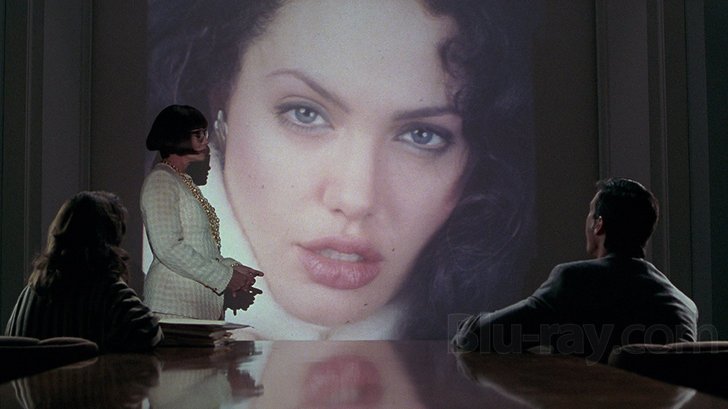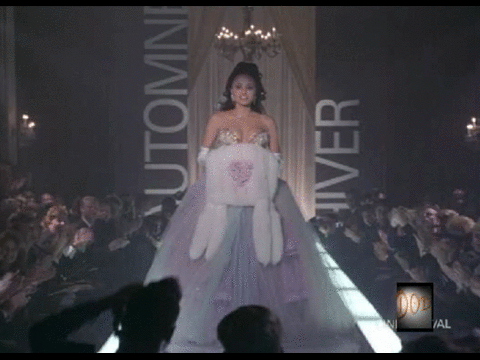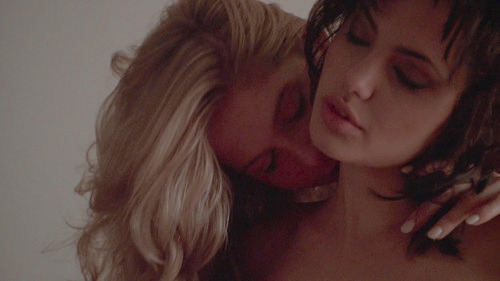Manuel is working his way through all the LGBT-themed HBO productions...
Last week we looked at the tender In the Gloaming, Christopher Reeve's directorial debut starring Glenn Close. And while that film ultimately focused on Close's character (her gay son is dying of AIDS), today, for the first time since we started this project, we get to focus on an LGBT protagonist that isn’t a gay man!
We follow instead a gorgeous woman (Angelina Jolie) who's as sexually adventurous as they come, leading on men and women alike, lighting the modeling world on fire, and falling hard (to the point of stalker-ish behavior) for a certain make-up girl that'll be all too familiar for all of you LOST fans.
Angelina Jolie's "Gia" breakthrough is after the jump...

Gia (1998)
[Watch on Amazon Prime & HBO Go]
Directed by: Michael Cristofer
Written by: Jay McInerney, Michael Cristofer
Starring: Angelina Jolie, Faye Dunaway, Elizabeth Mitchell, Eric Michael Cole, Mercedes Ruehl and Mila Kunis (as young Gia!)
 If there's one thing Gia Carangi knows how to do is make an entrance (she was, after all, one of the most sought out models of the late 70s). The same could be said of Jolie (she is, after all, one of the most sought after stars of the 2000s). The initial moments of Michael Cristofer's Gia function as a grand entrance for both women; we hear of Gia from family and friends while seeing someone applying makeup to her face. And then, like an imposing and seductive tornado, she materializes on a runway. She's stunning. She's vibrant. She loves the crowd. The crowd loves her. And then, then things get interesting. She's high on something (heroin, we later learn) and as she starts losing control, disrupting the scene like she’s in a rock band ("I should've been a rockstar... but I can't sing!" she remarks at one point). Eventually she makes it backstage where she collapses, looks of disdain, and impatience surrounding her.
If there's one thing Gia Carangi knows how to do is make an entrance (she was, after all, one of the most sought out models of the late 70s). The same could be said of Jolie (she is, after all, one of the most sought after stars of the 2000s). The initial moments of Michael Cristofer's Gia function as a grand entrance for both women; we hear of Gia from family and friends while seeing someone applying makeup to her face. And then, like an imposing and seductive tornado, she materializes on a runway. She's stunning. She's vibrant. She loves the crowd. The crowd loves her. And then, then things get interesting. She's high on something (heroin, we later learn) and as she starts losing control, disrupting the scene like she’s in a rock band ("I should've been a rockstar... but I can't sing!" she remarks at one point). Eventually she makes it backstage where she collapses, looks of disdain, and impatience surrounding her.
We're then treated, in true biopic fashion (pun intended) to Gia's rise from Philadelphia punk tomboy to supermodel of the world, most of it due to her outspoken personality - she famously carved her name on the desk of the receptionist at Wilhelmina Cooper (Faye Dunaway)’s office. The film follows the well-worn addiction narrative with many breakdowns, rehab stints, second chances and a sad end (Carangi was one of the first women to be diagnosed with AIDS). What is undeniable is Jolie's magnetic performance. It's a great warm up for her role in Girl, Interrupted but also that rare star making turn that fit her persona almost too well. Seeing Gia seduce, cajole, and entice men and women to do her bidding and relishing shocking those around her seems as good a description of Jolie circa 1998 as I can come up with; this is, let us remember, a mere year before the tabloids would seize on her sisterly kiss at the Oscars and on the blood vial she wore took to wearing around her neck!
She's just as strong in the quieter moments of the film, with a looseness that’s refreshing to see from an actress I've long associated now with imperious looks, deliberate movements, and calculated gestures. But here, she's all loose limbs and gawky movements, the grace on the runway and on photos belying an inner awkwardness about her own body. When not modeling, Jolie's Gia is contorting herself on couches, beds, and airplane seats, never quite comfortable in her own skin, seeking refuge in drugs and self-destructing behavior.

She was like a puppy. She was like... love me, love me, love me, love me... and I did. I did. I did right away. She was my lover. The only person I really loved. - Linda, on Gia.
And then of course there’s the sex. It's taken us six (!) films and ten years but with Gia we finally get a same-sex sex scene in an HBO film. Perhaps unsurprisingly, it is a lesbian scene that is quite literally staged in front of a gawking man (during a photoshoot where Gia convinces shy makeup girl Linda to pose nude alongside her across a chainlink fence). They continue their fling at Gia's that night and Cristofer's camera lingers on both their bodies leading me to believe lesbian sex is comprised of a lot of standing around caressing one another. It's risqué but oddly demure, and clearly in line with the fetishistic if toothless fascination on promiscuous sex Cristofer’s later films (Body Shots, Original Sin) would double up on. Erotic and non-voyeuristic same-sex sex it would seem, is the next frontier.

Fun Awards Fact: Jolie and Dunaway won hers & hers Golden Globes for their performances, Dunaway winning in a tie with Camryn Manheim from The Practice (they loved themselves some David E. Kelley that year; The Practice won Best Drama and Best Actor, while Ally McBeal won Comedy that year!). Also of note, Jolie won a SAG Award for Gia, an award she would win the following year for Girl, Interrupted; I was trying to think of other back-to-back winners (not for the same role which SAG members love to do) but was coming up empty; anyone have any stats like those handy?
Next week we’ll be shifting gears and focusing on a pivotal year for HBO’s television production. 1998 saw the premiere of Sex and the City and the end of The Larry Sanders Show, while established shows like Oz and Tracey Takes On were continuing to build the brand that would, with 1999’s debut of The Sopranos, prove to finally live up to its tagline: It’s not TV, it’s HBO. 1998 we’ll find out, is also the year we could say HBO comes out in full swing, with episodes in all of these aforementioned shows that found humor and humanity in various aspects of LGBT life.
So catch up on “The Turtle and the Hare,” “Putting The Gay Back in Litigation,” “Strange Bedfellows” and “Tracey Takes on Marriage.”